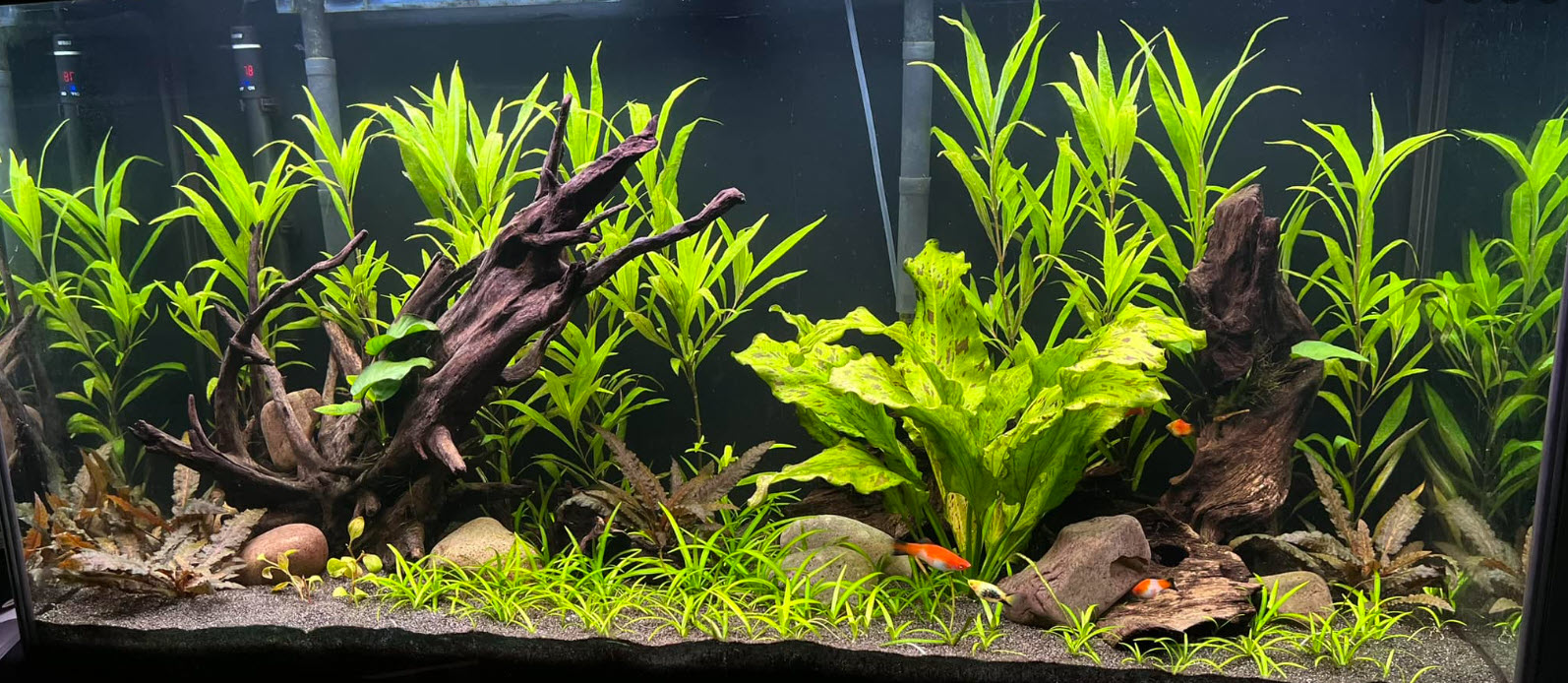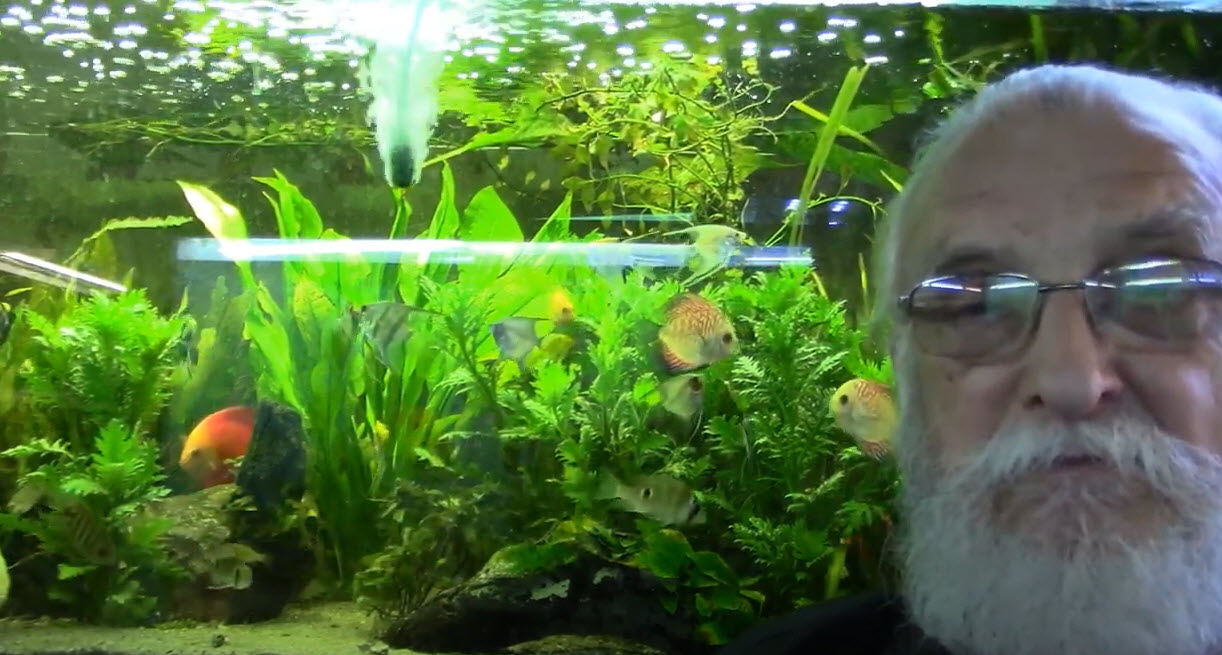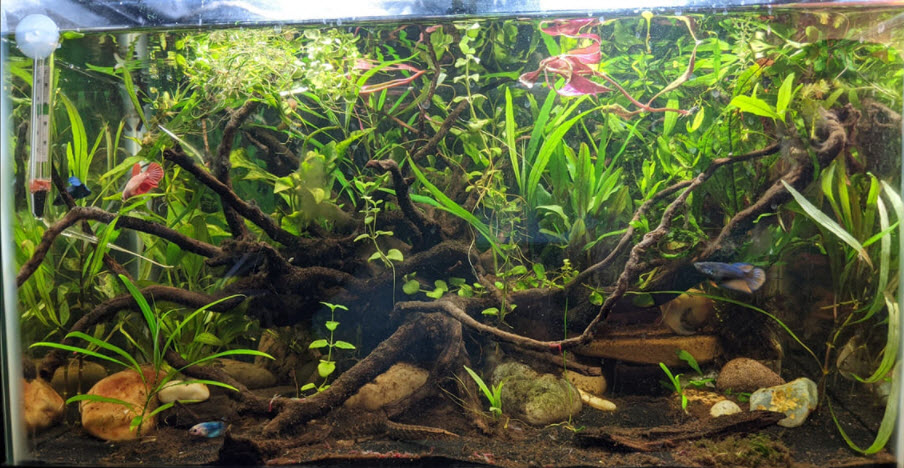
Another system that uses a filtered “natural” planted system with some air stone aeration can be perused in the popular YouTube channel “Father Fish”, Lou Foxwell (great YouTube channel, even if, like all of us “older” folks, he tends to ramble on a bit). The Father Fish system he uses is somewhat different than most low-tech planted approaches and radically different than the high-tech planted approaches. The system he uses can be summarized as follows:
- Heavily planted with lots of easy “green” plants
- Light stocking of small to medium sized fish
- Filtration via “deep substrate”, “detritus” and plants
- Small air stone or no air stone
- Water changes ONLY “when needed” (depends on plant density)
- Very light feeding (some cases no feeding)
- Fertilization only from food and compost substrate
- Rich compost under three inches of sand, carefully planted to prevent any contact between the compost and the water column
- Heavy lighting
- Inoculated with pond mud
Father Fish used an organic deep sand bed in what appeared to be about one hundred moderately stocked fish aquariums in his store (it is now closed). Father Fish added a whole bunch of “stuff” to very organic potting soil (looks like African violet mix to me). He used one inch of this soil mix for the first inch in his deep sand bed planted low tech aquariums.

He added worm castings, peat moss, Black Kow compost, blood meal, organic snail food, iron supplement, Osmocote, lime, and Epsom salts. He then added three to four inches of sand over that mix. He inoculates the aquariums with pond mud (“dead leaves” from a pond). Father Fish calls this a “natural” aquarium.
Father Fish has used this method for his many low tech planted aquariums. The lower three inches of the substrate in all his tanks is dark black in color from humus. His filters are sumps with five inch deep sand beds in them. The ammonia and dissolved organic compounds (DOCs) are consumed by mulm and detritus above and in the sand. The mulm and detritus, in turn, is consumed by a whole host of tiny critters that Father Fish introduces with his pond mud inoculate.
Father Fish has some very intense lighting, like ten “true” watts of LED lighting per ten gallon. But he doesn’t have algae.
Father fish does create a mature aquarium (and simultaneously “cycles”) with a different methodology than I do. He heavily plants an aquarium (one plant per gallon), adds a few fish, then leaves it with the lights on for 24 hours a day for a month or two. This works well for him. This just points out how flexible Mother Nature is.
Father Fish has some very healthy fish and some very healthy plants so his methods work. But note the water in his tanks tends to be slightly yellow and somewhat murky so I’m just not a big fan of his methods (he admits this in several of his videos). To avoid this one can simply take the filtration levels up to much higher levels. Note that a highly filtered Father Fish tank is still a natural ecosystem with all the inherent benefits of such an ecosystem.
It appears Father Fish is doing most of his biofiltration inside his aquariums with the surfaces of plants, detritus, mulm, substrate and decorations.
Note that Father Fish sells his soil mix and plants.

Father Fish has recently begun recommending the addition of handfuls of brown leaves to an aquarium. Several of my readers have tried this and ended up with cesspools (“soupy black water”). We do NOT recommend this methodology. Adding handfuls of brown leaves is the same as overfeeding an aquarium. It takes the dissolved organics (DOCs) high, the oxygen goes low because of a high biological oxidation demand (BOD), and a high carbon to nitrogen ratio insures a murky bacteria filled water.
Beginners always do something overboard. A few brown leaves won’t hurt anything. But handfuls can result in a cesspool filled with dead and dying fish. Several of my readers have now done just this and had catastrophic results (tankful’s of dead fish).
.
Return to Planted Tank Menu
.
Aquarium Science Website
The chapters shown below or on the right side in maroon lead to close to 400 articles on all aspects of keeping a freshwater aquarium. These articles have NO links to profit making sites and are thus unbiased in their recommendations, unlike all the for-profit sites you will find with Google. Bookmark and browse!
